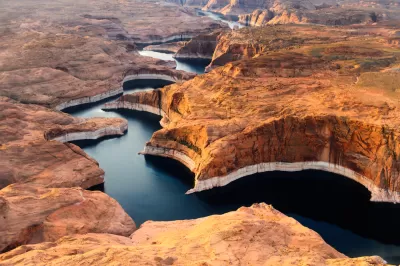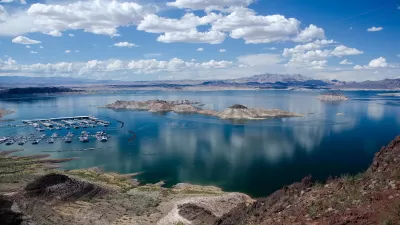State officials claim a proposal agreed upon by the other six states using Colorado River water disproportionately impacts California farmers.

Reporting for the Los Angeles Times, Ian James outlines California’s alternate proposal for managing the Colorado River’s dwindling water resources. “The state put forward its proposal a day after Arizona, Colorado, Nevada, New Mexico, Utah and Wyoming released their alternative.”
California officials claim the state’s “high-priority senior water rights dating back more than a century” must be protected under any new agreement. According to California’s natural resources secretary Wade Crowfoot, “The six-state proposal directly and disproportionately impacts California.” Much of the Colorado River’s Southern California allocations go to the region’s vast farmlands. Per the six-state plan, “A large portion of the cuts they proposed would be made by accounting for evaporation and other water losses along the lower portion of the river — a calculation that would translate into especially large reductions for California, which uses more Colorado River water than any other state.”
As James explains, “The state’s proposal builds on a previous commitment by four Southern California water agencies to cut water use by 400,000 acre-feet per year, a reduction of about 9%, through 2026. The federal government has asked the states to reduce their total usage by 2 to 4 million acre-feet.” California officials call the proposal “a realistic and implementable framework to address reduced inflows and declining reservoir elevations by building on voluntary agreements and past collaborative efforts in order to minimize the risk of legal challenge or implementation delay.” As the states continue to debate, federal officials plan to finalize an agreement this summer.
FULL STORY: California offers proposal on Colorado River crisis, disagreeing with six states

Planetizen Federal Action Tracker
A weekly monitor of how Trump’s orders and actions are impacting planners and planning in America.

Map: Where Senate Republicans Want to Sell Your Public Lands
For public land advocates, the Senate Republicans’ proposal to sell millions of acres of public land in the West is “the biggest fight of their careers.”

Restaurant Patios Were a Pandemic Win — Why Were They so Hard to Keep?
Social distancing requirements and changes in travel patterns prompted cities to pilot new uses for street and sidewalk space. Then it got complicated.

California Homeless Arrests, Citations Spike After Ruling
An investigation reveals that anti-homeless actions increased up to 500% after Grants Pass v. Johnson — even in cities claiming no policy change.

Albuquerque Route 66 Motels Become Affordable Housing
A $4 million city fund is incentivizing developers to breathe new life into derelict midcentury motels.

DC Area County Eliminates Bus Fares
Montgomery County joins a growing trend of making transit free.
Urban Design for Planners 1: Software Tools
This six-course series explores essential urban design concepts using open source software and equips planners with the tools they need to participate fully in the urban design process.
Planning for Universal Design
Learn the tools for implementing Universal Design in planning regulations.
Heyer Gruel & Associates PA
JM Goldson LLC
Custer County Colorado
City of Camden Redevelopment Agency
City of Astoria
Transportation Research & Education Center (TREC) at Portland State University
Camden Redevelopment Agency
City of Claremont
Municipality of Princeton (NJ)





























